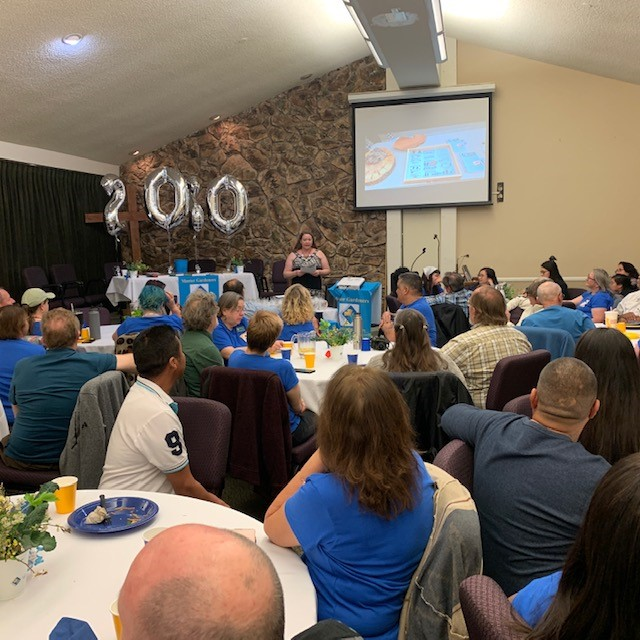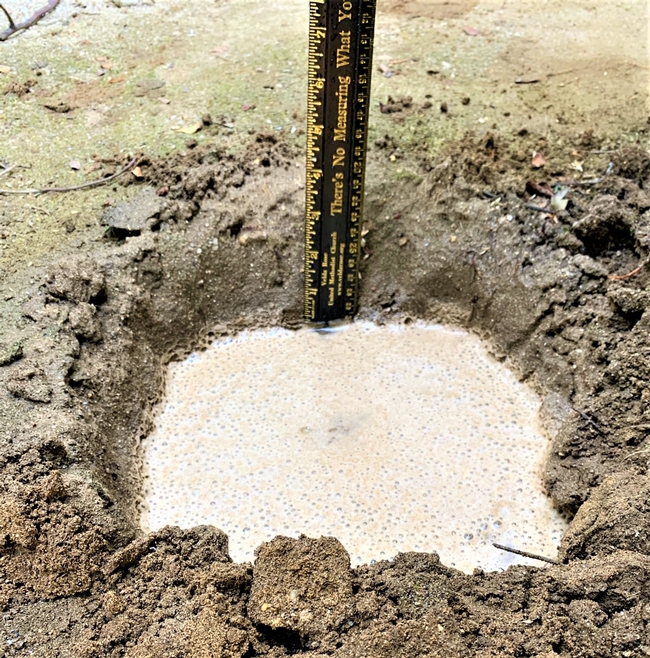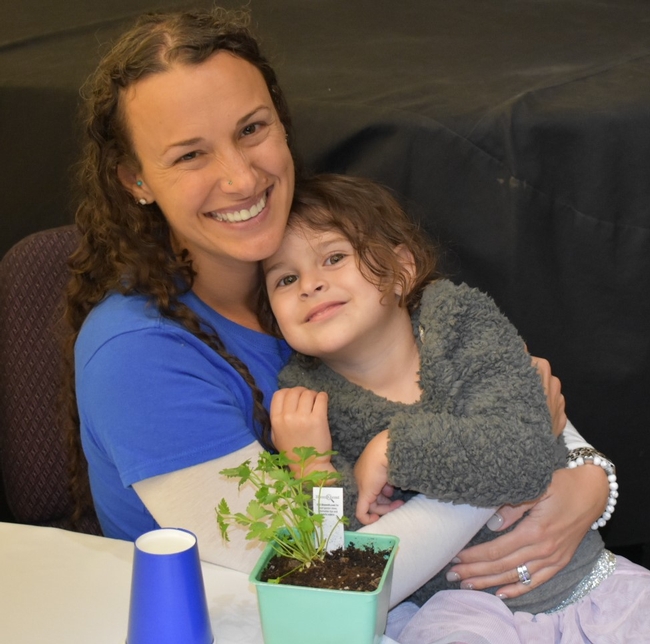- Author: Janet Hartin
A major focus of the UC Cooperative Extension (UCCE) Master Gardener program in San Bernardino, Riverside and - more recently, Los Angeles County - is to implement the “Trees for Tomorrow Start Today” project in partnership with over 30 other community-based partners and agencies including the South Coast Air Quality Management District, Inland Empire Resource Conservation District, Coachella Valley Resource Conservation District, various water agencies, cities, and grass-roots partners whose members have specifically requested green solutions to cool urban heat islands. Over the past five years, over 3,000 climate-resilient trees have been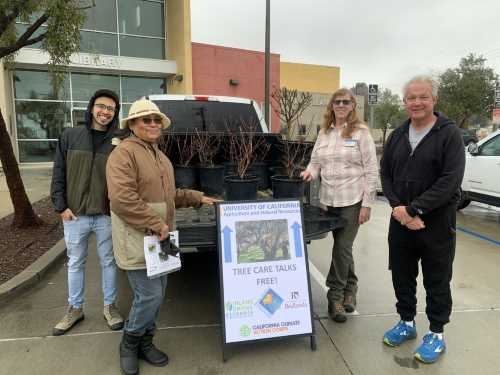
Why is this project so important? California has the lowest per capita tree canopy cover in the United States, a mere 108 square feet, disproportionately impacting people of color. Many neighborhoods in San Bernardino, Los Angeles and Riverside Counties have tree canopy cover far below the recommended 25% - 40%, which is directly linked to extreme heat, high ozone concentrations, and high rates of cardiovascular and pulmonary diseases. A major reason for this low canopy cover is often due to fewer trees being planted on public and private properties in disadvantaged communities. Other reasons are tree loss due to poor tree species selection and lack of long-term maintenance, resulting in fewer than 40% of urban trees, on average, living beyond 20 years.
An important aspect of the project is its strong bilingual educational component that includes written tree planting and care information and in-person presentations describing the attributes of the climate-resilient tree species offered and tree care tips. Both help ensure that trees reach maturity, maximizing their ecosystem and social benefits. Another key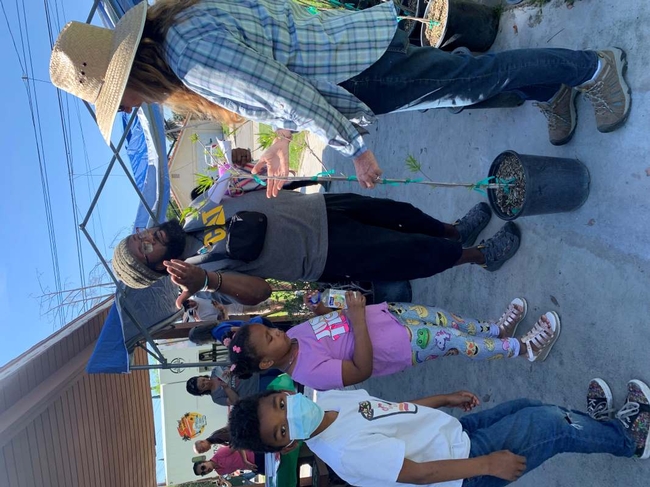
How do we select appropriate tree species? From the results of UC research and other credible sources. I've been fortunate to co- lead a project going into its 9th year at UCR, along with other ANR and USFS colleagues, to identify underplanted species of climate-resilient trees. While the project will continue for another 12 years, it's important to note that, to date, all but two of the twelve species in the trial (even with the irrigation water turned off since March 2020 which included 2-1/2 years of severe drought) are performing well with no major health issues.
Please contact me at jshartin@ucanr.edu if you'd like to be a partner or contribute trees or funding to purchase them. We are a non-profit 501(c)(3) organization, and your tax-deductible contribution is deeply appreciated!
With gratitude,
Janet Hartin
- Author: Janet Hartin
ANR Environmental Horticulture (EH) academics develop and extend research-based information to producers and end-users of landscape, nursery, turfgrass, and floriculture plants. Our work focuses on optimizing the environmental, social, and economic benefits plants provide while conserving and protecting natural resources required for their production, use, and care.
Research and education we provide is aligned with the following ANR public value statements:
- Protecting California's natural resources
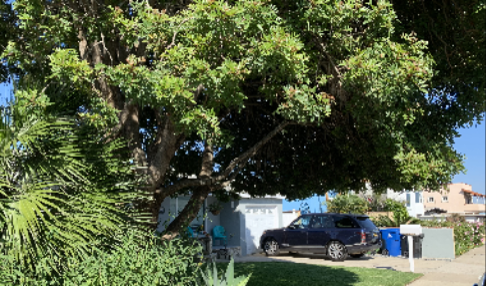
- Building climate-resilient communities and ecosystems
- Promoting healthy people and communities
- Developing a qualified workforce
- Developing an inclusive and equitable society
Our applied research and education is relevant to all five ANR Strategic Initiatives (Endemic and Invasive Pests and Diseases; Sustainable Natural Ecosystems; Sustainable Food Systems; Healthy Families and Communities; and Water Quantity and Quality).
Crucially, it impacts all urban Californians (95% of our population) by increasing the sustainability of our living urban environments and enhancing physical and mental health. We help remedy the historical inequality in the distribution of environmental benefits through research and education we extend to plant producers, arborists, park superintendents, landscapers, planners, community-greening non-profit organizations, and others supporting urban sustainability and environmental justice.
While our work is beneficial to all, it is especially critical in resource-limited cities, neighborhoods and communities most negatively impacted by climate-change.
Issues Adressed by ANR EH Academics:
Reducing Impacts of Climate Change in Our Cities. Properly selected and maintained urban trees, shrubs, and turf mitigate the impacts of climate change by cooling urban heat islands, reducing energy use, providing shade, and sequestering carbon dioxide. Trees reduce surface temperature of urban heat islands in inland and desert cities in California up to 20°C (68°F) and air temperatures up to 2.0°C (35°F). Due to climate change and urbanization, the rate, intensity, and duration of heatwaves in these urbanized areas are increasing, as is the number of heat-related deaths. Members of underserved and disadvantaged communities are at high-risk of experiencing health-related consequences of climate change, further exacerbated by living in neighborhoods with low tree canopy cover and hotter conditions. The poorest Californians are often the most impacted by climate change, leading to a form of endemic and prolonged social injustice.
Our applied research and education focuses on identifying heat, drought, and pest-resistant trees that withstand impacts posed by a warming climate and urban heat islands. Managers of trees in disadvantaged neighborhoods, parks, schools, and green spaces often lack resources to hire outside experts to assist them with proper tree selection and care, relying heavily (and sometimes exclusively) on our trusted, objective expertise. We provide location-specific, relevant and scientifically-supported information on complex technical issues related to horticulture, arboriculture, water management, and policy. Our technical expertise helps the green industry produce and properly maintain landscape trees and shrubs best equipped to perform under the pressures of climate change and mitigate its impacts. Our work directly leads to cooler, more habitable communities and neighborhoods, demonstrating our important role supporting environmental justice and climate change mitigation.
Reducing Water Use in Commercial, Public, and Residential Landscapes. Our involvement in research and education measuring evapotranspiration (ET) rates and determining the minimum irrigation requirements of landscape species spans over 30 years. Early work included the design and implementation of the California Irrigation Management Information System (CIMIS) weather station network and determining crop coefficients for warm and cool season turfgrass based on historical ET and CIMIS data.
Our work identifies the minimum irrigation requirements of established landscape trees, shrubs, and groundcovers in diverse climate zones throughout the state, supporting urban water conservation. Through a partnership with the California Department of Water Resources, we developed the Water Use Classification of Landscape Species (WUCOLS) system in the early 1990s which, to date, has classified more than 3,500 landscape plant species into very low, low, moderate, and high water-use categories based on observation and personal experience by UC and industry experts. WUCOLS continues to be updated as we obtain more data from replicated trials. Our work in precision irrigation using smart controllers, remote sensing, and geospatial analysis under controlled conditions improves irrigation efficiency. Irrigation training and certification for public and private landscape managers also remains a priority because, even with advanced smart controller technologies, water savings cannot occur with poorly designed and malfunctioning irrigation systems.
We also develop and extend critical information leading to the formation of statewide water budgets and policy for commercial and residential users through participation on legislator-appointed boards and committees. Our work reduces the obstacles that were inhibiting widespread landscape water conservation including: a lack of credible information regarding landscape water requirements, inadequate training across a large segment of the landscape industry, lagging irrigation system technology, and an inadequate supply of locally available drought-resistant landscape plants.
Reducing Overuse of Pesticides and Fertilizers in Commercial, Public, and Residential Landscapes. Urban landscapes are now the single greatest source of non-point pesticide pollution of California waterways. Home use of pesticides is unregulated, and residential users are often unaware of proper application practices leading to runoff polluted with fertilizers and pesticides. Inefficient irrigation practices by residents and professional landscape managers contribute significantly to runoff leading to waterway pollution. Applied research and education that we develop and extend through the Green Gardener and other educational programs directed at the commercial sector and through the ANR Master Gardener Program (MGP) to non-commercial gardeners reduces reliance on pesticides and fertilizers in urban environments, further reducing water pollution.
Preventing and Controlling Pests and Diseases in Commercial Nurseries/ Greenhouses/ Controlled Environments and Landscapes. Global trade and illegal imports of plants from unlicensed facilities have introduced devastating pests and diseases that irreversibly impact production, end-user sectors of the green industry, and California's natural landscapes, often requiring expensive, area-wide control programs. As global trade and movement of pests into California continue to increase populations of exotic pests and diseases, the need for applied research in detecting and managing them in production nurseries and landscapes has also increased. We help protect California's green infrastructure from the threat of pests and diseases by developing, updating, and implementing science-based best management practices that contain and control them.
We regularly train arborists, growers, land managers, and other green industry personnel to identify and manage a wide variety of pests and diseases, including new invasive species. We also provide education to ANR MGP volunteers and the general public on ways to reduce the spread of invasive species and, in some cases, we involve citizen scientists in our work detecting invasive tree pests.
Addressing Water Quality and Quantity Issues in Nurseries/Greenhouses/Controlled Environments. Federal, state, and local governments mandate elimination and/or reduction of wastewater discharges that exceed established water quality criteria. The passage of the Sustainable Groundwater Management Act in 2014 to protect groundwater resources brought us and ANR colleagues in related disciplines to the forefront working with regulatory agencies and industries to develop long-term groundwater sustainability plans and address fertilizer management to mitigate groundwater pollution.
In addition, due to water scarcity and imposed restrictions due to drought, we develop and extend research-based information to enable water conservation while supplying adequate amounts of water to produce high-quality, functional plants. We also develop technologies and systems to improve the quality and delivery of recycled water which reduces reliance on potable water but can impair irrigation water quality, leading to plugging of nozzles, high substrate salt levels, and plant damage. Our expertise helps nursery and floriculture producers obtain and retain sustainable alternative water sources that minimize dependence on potable water without diminishing long-term economic viability.
Enhancing Human Health and Well-being/Quality of Life. Our work improves the health and quality of life of all Californians benefiting from products and services provided by the green industry. Numerous studies document the myriad ways that landscapes enhance our physical, psychological, sociological, and emotional well-being. Besides providing sources of exercise and recreational opportunities (parks, schoolyards, sports fields, etc.), research affirms that gardening and exposure to nature enhances work productivity, mood, creativity, social bonding, cognition, mental acuity, and a sense of belonging. Studies have also shown that indoor flowering plants reduce stress and improve concentration, productivity, and happiness. In addition, many people engaged in horticulture therapy activities with trained professionals recover more quickly and fully from physical injuries with improved mental health. It is now widely recognized that separation from peaceful, landscaped environments causes stress, increased crime rates, decreased life-spans, and increased incidence of chronic disease in densely populated and sparsely vegetated urban areas, even when controlled for education, race, and income.
Providing ANR MGP Oversight/Research and Extension. We provide vital program oversight and research-based information to over 6,000 ANR MGP volunteers who, in turn, use this information to teach the public how to landscape more sustainably and grow food. Our work provides the foundation to ensure that accurate information is conveyed to the public, ultimately helping protect California's natural resources, reducing overuse and misuse of pesticides, supporting locally grown food, and enhancing health and the quality of life for all Californians.
ANR MGP volunteers are a trusted source of objective research-based information by the gardening public, recording over 395,000 volunteer and continuing education hours in 2019/2020. Surveys completed by Californians after participating in ANR MGP volunteer-led events and classes during this same period document the impact of the program: 74% monitor for insects, weeds, and diseases, which reduces the use of pesticides and waterway pollution; 73% use improved practices to grow food, which reduces food deserts and improves health; 69% spend more time outdoors, which enhances individual and community health; and 67% make use of more plants that attract and support pollinators, which enhances biodiversity and a healthy ecosystem. Our role in providing oversight and research-based information through the MGP will become even more vital due to increased interest in landscaping and gardening by the public. More than four in ten U.S. households (42%) report participating in food gardening in 2020, significantly higher than in 2019 (33%). Importantly, participation by lower income populations, people of color and younger people has outpaced many other demographics.
Developing a Qualified “Green Collar” Workforce for California. Our outreach is critical to familiarize and train interested Californians for green industry careers (arboriculture, landscape pest management, urban water management, nursery, floriculture, controlled environments, etc.) at all educational levels, from those entering the skilled trade to mid-level managers and seasoned professionals and educators seeking to advance their careers and stay abreast of scientific developments. We are front-line teachers for many adult education programs focused on green industry training, often through trade groups and professional associations. Because we are familiar with the local workforce and issues pertinent to clientele in counties we serve, we play a particularly vital role educating the green industry. Often, we are the only source of research-based information locally for early-career individuals with limited resources unable to attend conferences miles away. In addition, we often provide subject-matter material in Spanish through the Green Gardener and other valued programs. As noted below, not only is professional development critical to the individual workers, but a knowledgeable workforce is essential for the proper care and maintenance of California's urban green infrastructure.
Size and Scope of California's Environmental Horticulture Industries
Nursery & Floriculture. The California nursery and floriculture industries have a farm gate value of $3.73 billion (annual average from 2013-2017) and $3.74 billion in 2019, the largest in the United States, accounting for over 20% of U.S. production from 2,609 operations. In fact, only dairy and milk, almonds, and grapes have higher farm gate economic values in California. In addition, California producers accounted for 14% of national bedding and garden plant sales, 34% of potted flowering plant sales, and 78% of total wholesale cut flowers. In 2017, San Diego County ($1.19 billion) dominated California with 43.3% of the state's nursery and floriculture production. (San Diego County and 8 other counties each realized over $100 million and produced $2.25 billion of production). Stanislaus, Monterey, Ventura, Santa Barbara, and Riverside combined were the next largest producers, accounting for 38.7% of total nursery and floriculture production in California. Nursery and floricultural crops ranked in the top 10 agricultural commodities in 36 of California's 58 counties that reported agricultural production.
Landscape Horticulture. The value of the landscape industry in California has been steadily rising as well, totaling over $11 billion of products and related services in 2017. There are more arborists in California (9,560) than any other U.S. state and this number is expected to grow by 11.6% (1,300 jobs) between by 2028. Unfortunately, this increase coincides in many cases with the prevalence of poorly trained, non-certified tree care workers unaware of best practices necessary for ensuring the health and longevity of our urban trees. Less than 10% of individuals in California providing tree care service are certified through the International Society of Arboriculture, a professional development process that increases the competency of an individual's abilities to provide proper tree selection and care and ensures ethical practices.
Bibliography
Aldridge, J. & Sempik, J. (2002) Social and therapeutic horticulture: Evidence and messages from research. CCFR Evidence, 6, 1-4. Anderson G.B. & Bell M.L. Heat waves in the United States: mortality risk during heat waves and effect modification by heat wave characteristics in 43 US communities. Environ Health Perspect. 2011;119(2):210.
Berman, M.G., Jonides, J. & Kaplan, S. (2008) The cognitive benefits of interacting with nature. Psychological Science, 19, 1207-1212. Blair, D. (2009) The child in the garden: An evaluative review of the benefits of school gardening. Journal of Environmental Education, 40(2), 15-38.
Burger, D. (2000) The State of Environmental Horticulture in California: a White Paper for UC-DANR, (Growing Points: Vol. 4, Number 4, Fall). Retrieved from: http://groups.ucanr.org/ehric/documents/Growing_Points4795.pdf.
Butterfield, B. (2009) The impact of home and community gardening in America. National Gardening Association. Retrieved from: http://www.gardenresearch.com/home?q=show&id=3126.
Carmen, H. (2020) Chapter 12: California nursery and floral industry. Giannini Foundation of Agricultural Economics. 2020. Retrieved from: https://s.giannini.ucop.edu/uploads/pub/2021/01/21/chapter_12_nurseryfloral_2020.pdf CDFA)
California Agricultural Statistics Review (2019-2020). California Department of Food and Agriculture. Retrieved from: https://www.cdfa.ca.gov/Statistics/PDFs/2020_Ag_Stats_Review.pdf.
Chen Y. (2017) The impact of biophilic design on health and wellbeing of residents through raising environmental awareness and nature connectedness. University of Georgia Masters Thesis. Retrieved from: chen_yingting_201708_mla.pdf (uga.edu)
Gable, M. & Womack, M. (2020) UC ANR Master Gardener Program Annual Impact Report for 2019/2020. Retrieved from: https://bit.ly/3j6oisl
Gerrish E. & Watkins, S.L. The relationship between urban forests and income: A meta-analysis. Landsc Urban Plan. 2018;170:293–308. pmid:29249844
Hartig T., Van-den-Berg A., Hagerhall C. et al. (2011) Health benefits and nature experiences: psychological, social and cultural processes. In: Forests, trees and human health. Dordrechtr: Springer; 2011. p. 127–168
Hartin, J., Fujino, D., Reid, K., Ingels, C., Haver, D., & Baker, W. (2019) UC ANR research and education influences landscape water conservation and public policy. California Agriculture. 73:1, 25-32. Retrieved from: https://doi.org/10.3733/ca.2018a0041
Hartin, J.S., Fujino, D.W., Oki, L.R., Reid, S.K., & Ingels, C.E. (2018) Water requirements of landscape plants studies conducted by the University of California researchers. HortTechnology. 28:4, 422-426. August. Retrieved from: https://journals.ashs.org/horttech/view/journals/horttech/28/4/article-p422.xml
Jesdale B.M., Morello-Frosch R. & Cushing L. The racial/ethnic distribution of heat risk–related land cover in relation to residential segregation. Environmental health perspectives. 2013;121(7):811–7.
Jenerette G.D., Harlan S.L., Buyantuev A., Stefanov W.L., Declet-Barreto J., Ruddell B.L., et al. Micro-scale urban surface temperatures are related to land-cover features and residential heat related health impacts in Phoenix, AZ USA. Landsc Ecol. 2016;31(4):745–60.
Kroeger T., McDonald R.I., Boucher T., Zhang .P, & Wang L. Where the people are: Current trends and future potential targeted investments in urban trees for PM10 and temperature mitigation in 27 U.S. cities. Landsc Urban Plan. 2018;177:227–40.
Kuo, Ming. (July, 2021). Trees are Essential- Growing Human Health and Equity. California Urban Forests Council. Retrieved from: https://caufc.org/trees-are-essential-growing-human-health-equity/ Landry S.M. & Chakraborty J. Street trees and equity: evaluating the spatial distribution of an urban amenity. Environment and Planning a. 2009;41(11):2651–70.
Masashi Soga, Masashi, K. Gaston & Yamaura, Y. (2017) Gardening is beneficial for health: A meta-analysis. Preventive Medicine Reports, vol.5, pp: 92-99, ISSN 2211-3355. Retrieved from:https://doi.org/10.1016/j.pmedr.2016.11.007
McBride, Joe & Lacan, Igor (2018) The impact of climate-change induced temperature increases on the suitability of street tree species in California (USA) cities. Urban Forestry & Urban Greening. 34, 348-356. Retrieved from: https://www.sciencedirect.com/science/article/pii/S1618866718300013
McDonald R.I., Biswas T., Sachar C., Housman I., Boucher T.M., Balk D., et al. (2021) The tree cover and temperature disparity in US urbanized areas: Quantifying the association with income across 5,723 communities. PLoS ONE 16(4): e0249715. Retrieved from: https://doi.org/10.1371/journal.pone.0249715
McDonald R.I., Kroeger T., Zhang P., & Hamel P. The Value of US Urban Tree Cover for Reducing Heat-Related Health Impacts and Electricity Consumption. Ecosystems. 2020;23:137–50.
Newman, Julie P., Kabashima, John N., Merhaut, Donald, Haver, Darren L., Gan, Jay, Oki, Lorence R. (2014) Controlling Runoff and Recycling Water, Nutrients, and Waste. Container Nursery Production and Business Management Manual, ANR Manual 3540: 95-118.
Reid, K., Fujino, D., Oki, L., Hartin, J., et al. (2018) Maintaining urban landscape health and services on reduced irrigation: A multi-site study in best management practices. ActaHortic.2018. 1215. Retrieved from: https:/doi.org/10.17660/ActaHortic.2018.1215.33
Reid, K. & Gable, M. (2020) University-trained volunteers use demonstration gardens as tools for effective and transformative community education. Acta Hortic. ISHS. 1298, 85-90. December. Retrieved from: https://doi.org/10.17660/ActaHortic.2020.1298.13
Riley C.B. & Gardiner M.M., Examining the distributional equity of urban tree canopy cover and ecosystem services across United States cities. PLoS ONE. 2020;15(2):e0228499.
State of California. (2021) Economic Development Department/LMID Projections of Employment by Occupation. Retrieved from: https://www.labormarketinfo.edd.ca.gov/OccGuides/Detail.aspx?Soccode=373013&Geography=0604000059
Troy, A., Grove, J.M. & O'Neil-Dunne, J. (2012) The relationship between tree canopy and crime rates across an urban-rural gradient in the greater Baltimore region. Landscape and Urban Planning, 106 (3) 262-270.
Twohig-Bennett C. & Jones A. The health benefits of the great outdoors: A systematic review and meta-analysis of greenspace exposure and health outcomes. Environ Res. 2018;166:628–37. USDA California Agricultural Statistics (2017) Retrieved from: https://www.nass.usda.gov/Publications/AgCensus/2017/Full_Report/Census_by_State/California/index.php
Weinberger, Kate R., Harris, Daniel, Spangler, Keith R., Zanobetti, Antonellae & Wellenius, Gregory A. (2020) Estimating the number of excess deaths attributable to heat in 297 United States counties, Environmental Epidemiology: June 2020; 4(3) Retrieved from: https://agupubs.onlinelibrary.wiley.com/doi/10.1029/2020EF001480
Weston, D.P., Holmes, R.W., You, J., & and. Lydy, M.J. (2005) Aquatic toxicity due to residential use of pyrethroid insecticides. Environmental Science & Technology, 39(24): 9778-9784. Retrieved from http://dx.doi.org/10.1021/es0506354
- Author: Janet Hartin
Most trees in California need supplemental irrigation above and beyond what Mother Nature supplies naturally. Even drought-resistant species need regular watering through their first growing season due to their shallow roots. Once trees become established, it's important to water less often but more deeply to encourage deep rooting and structural balance above and below ground. Both under and overwatering can lead to unhealthy trees and even death if the situation is not corrected. Trees receiving too little or too much water exhibit similar symptoms since, in both cases, water is not available to the plant. Trees initially wilt, grow slowly, and develop yellow leaves. Over time, growth stops and leaves become brown and drop. Overwatered trees often develop lower crown and root rot from one or more disease-forming pathogens.
Knowing what type of soil you have (soil texture) is as important as knowing the water needs of your trees. Use the ‘feel test' (pictured below) to find out how much water your soil holds and how often to water. Heavier clay-based soils hold water longer and drain more slowly than sandier soils that need to be watered more often for shorter periods of time.
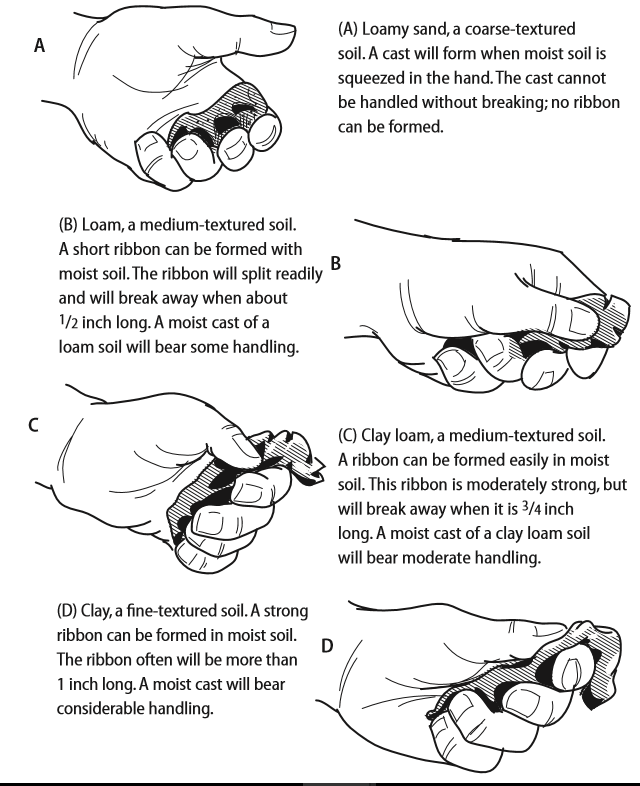
Trees should not be watered on the same irrigation system used for lawns and groundcovers. Soaker hoses and drip systems allow trees to be watered less often but for longer periods of time than your lawn or groundcover. Avoid applying water too close to the trunk. Instead water half-way between the trunk and the dripline of the tree and outward. If you use a garden hose, apply the water on the lowest volume possible slowly, moving the hose every few hours to each of four quadrants around the tree.
Applying a 3-4 inch layer of mulch around the tree can reduce soil evaporation. Use only non-flammable mulches in fire-prone areas within five feet from the house and non-contiguous for the first 30' away from the house. In all cases keep mulch a few inches away from tree trunks to keep the trunks dry.
Tip: Before planting a tree, make sure there is adequate drainage. Dig a hole where you want to plant it (the same depth of the pot, which is about one foot) and fill the hole with water. Let it completely drain and refill it. Measure the time it takes to drain one inch using a ruler. If it does not drain more than one inch an hour it is not a good location for your tree. Avoid adding compost or soil amendments to try to correct the problem since tree roots will likely grow in circles, staying within the confines of the amended hole rather than growing outward the confines of the amended hole rather than growing outward.
- Author: Janet Hartin
Dear Community Members and UCCE Partners Throughout San Bernardino County,
I hope this finds all of you and your families well and staying healthy. Please note that, due to COVID-19 concerns, all UCCE San Bernardino County face-to-face program activities, classes, and other events scheduled through April 30, 2020 have been postponed, canceled, or converted to zoom meetings or other distance learning formats. However, our academics, program managers, and community educators remain on the job and available to assist you via phone and email. Volunteer Master Gardeners continue to address your home horticulture inquiries through their telephone (909)387-2182 and email helplines (mgsanbern@ucanr.edu).
Thank you for your understanding and your flexibility as we continue to provide research-based information in new and novel formats during this difficult time. Follow us on twitter (@MGPSanBern and @UCANRJHartin) and visit our website http://cesanbernardino.ucanr.edu/ for more updates including our Fiscal Year 2019/2020 Annual Report.
Have you ever thought about the parallel between preventive health care for people and integrated pest management (IPM) for plants? Both implement specific measures that reduce the risk of exposure to disease-causing organisms. According to experts, implementing preventive measures such as ‘physical distancing' (I prefer that term over ‘social distancing'), washing our hands thoroughly and regularly, covering our mouths when we cough, not touching our face, etc. greatly reduce our chance of contracting COVID-19.
In the plant world, IPM practices and principles that promote healthy plants greatly reduce the chance of damage from diseases and other pests. With a little extra time on your hands, implement these IPM practices for a healthier garden and landscape: match plants to their preferred climates and microclimates; select disease resistant plant varieties; provide well drained, healthy soil amended with compost and other organic products when appropriate; apply the right amount of water and nutrients at the right time, etc.
A ‘silver lining' of adopting these practices is that the need for pesticides is greatly reduced which keep our waterways clean, and preserves (and even enhances) populations of beneficial microbes, pollinators and wildlife.
Here are some other ‘silver linings' that I want to share with you in hopes they will provide some inspiration for you to ‘landscape greener' during what I hope is some extra downtime.
• Fewer vehicles on the roads has temporarily improved our air quality. With some extra time on our hands, we can all contribute to a more permanent solution by planting a tree or two! Trees store carbon dioxide that reduces pollution, cool urban heat islands, provide shade, reduce interior energy use and costs, provide habitat, connect us with nature, and beautify our neighborhoods. 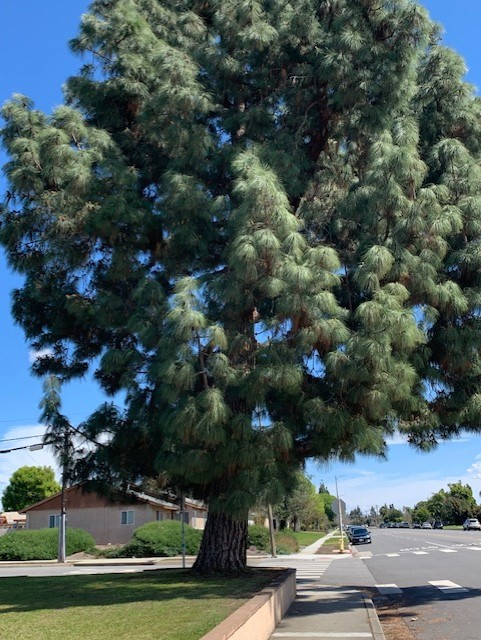
• Improve the health of your landscape trees by loosening tight tree stakes and ties and adjusting sprinklers to keep tree trunks dry. Your trees depend on you! 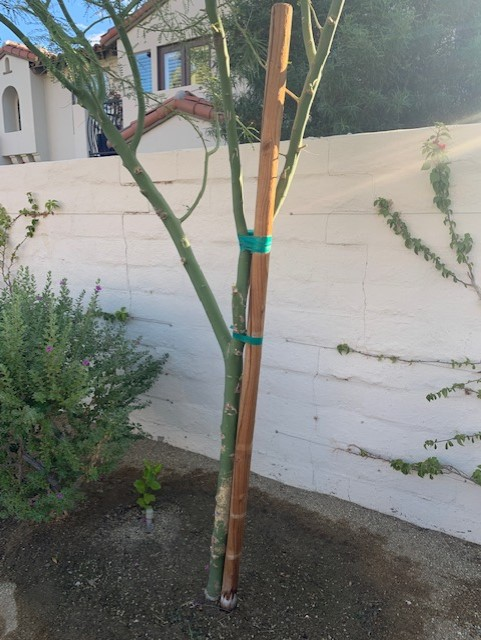
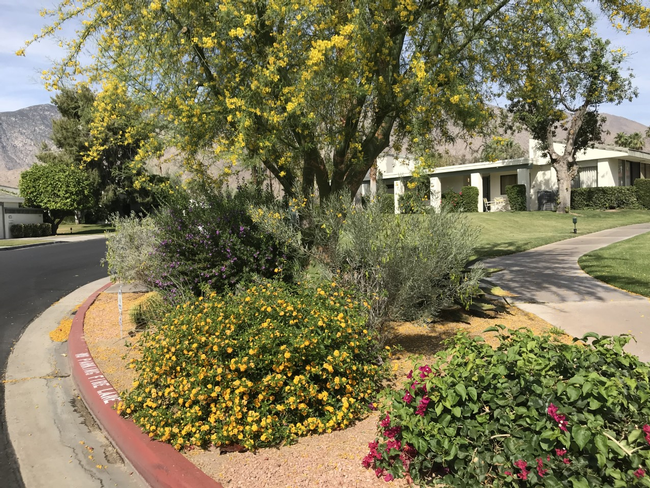
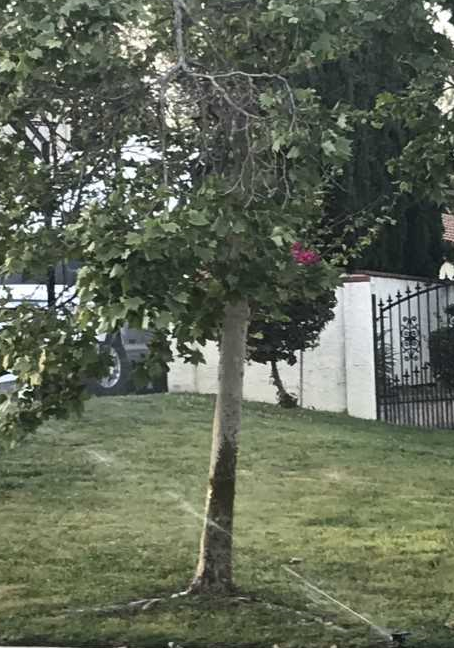
• Stay in touch with family, friends, and even co-workers at a distance via 'walking chats' that improve our physical health and even reduce stress by increasing the “feel good” hormone serotonin. Keep it up and it just might earn you a place in the “100 mile a month walking club.”
• With more time to catch up on reading, consider downloading free UC ANR publications such as: ‘Sustainable Landscaping in California' anrcatalog.ucanr.edu/pdf/8504.pdf that provides tips on water savings, use of soil amendments and mulch, reducing pesticide use, and more.
• More time on our hands provides an opportunity to stock our ‘little free library' with vegetable and flower seeds for our neighbors. Don't have an official ‘library'? Build your own ‘seed sharing box!' Or, donate seeds and plants to a local food bank or other non-profit.
I hope that you and your loved ones stay well and healthy! We will get through this together.
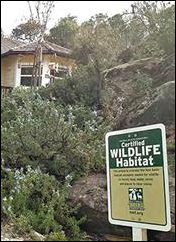
- Author: Janet Hartin
Congratulations to our 52 San Bernardino County University of California Cooperative Extension (UCCE) Master Gardener graduates from all corners of the county! Please help Master Gardener Coordinator Maggie O'Neill, previously certified Master Gardeners and myself welcome these new volunteers who completed their 18-week training course and graduated on February 18, 2020 in Loma Linda.
What does it take to become a UCCE Master Gardener? Dedication, passion, a strong desire to help local residents and communities garden more sustainably. Each graduate completed an 18-week training session with weekly classes on sustainable landscaping, growing vegetables and fruits in home, school, and community gardens, pest management, and building healthy communities. Course requirements included passing a midterm and final exam and presenting a class (project to peers in a group setting. Most importantly of all, graduates each made a pledge to volunteer at least 50 hours of their own time over a one year period to help residents of San Bernardino County garden smarter.
Thanks to the continued dedication of over 150 previously trained Master Gardeners, San Bernardino County now has the talents of over 200 knowledgeable Master Gardener volunteer who you will very likely meet at local events and activities from Chino Hills to Yucaipa as well as in desert and mountain communities alone or in partnership with over 75 collaborating agencies, cities, schools, and county departments.
Since a picture can paint 1,000 words, we hope you enjoy living vicariously through a few graduation photos! Fiends and family members alike enjoyed an evening of celebration in honor of their Superstars who they are rightfully very proud of!
Thank you to each and every one of our new graduates! You helped UC Cooperative Extension in San Bernardino County reach over 30,000 county residents each year garden more sustainably through public workshops and classes, information booths,Farmers Markets, telephone and email helplines, develop school and community gardens, and many other activities throughout San Bernardino County communities.
Are you interested in becoming a UCCE Master Gardener? The next 18-week class will be held at the Chino Basin Water Conservation District in Montclair on Saturday mornings starting in late Spring 2020. Please contact Master Gardener Coordinator Maggie O'Neill at magoneill@ucanr.edu for a link to the online application. Residents of San Bernardino County over the age of 18 are eligible to apply. No formal college degree is required. However, Department of Justice background clearance is required by the University of California prior to participating in any volunteer activities.
Congratulations graduates!

